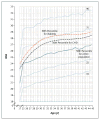Adolescent BMI trajectory and risk of diabetes versus coronary disease
- PMID: 21470009
- PMCID: PMC4939259
- DOI: 10.1056/NEJMoa1006992
Adolescent BMI trajectory and risk of diabetes versus coronary disease
Abstract
Background: The association of body-mass index (BMI) from adolescence to adulthood with obesity-related diseases in young adults has not been completely delineated.
Methods: We conducted a prospective study in which we followed 37,674 apparently healthy young men for incident angiography-proven coronary heart disease and diabetes through the Staff Periodic Examination Center of the Israeli Army Medical Corps. The height and weight of participants were measured at regular intervals, with the first measurements taken when they were 17 years of age.
Results: During approximately 650,000 person-years of follow-up (mean follow-up, 17.4 years), we documented 1173 incident cases of type 2 diabetes and 327 of coronary heart disease. In multivariate models adjusted for age, family history, blood pressure, lifestyle factors, and biomarkers in blood, elevated adolescent BMI (the weight in kilograms divided by the square of the height in meters; mean range for the first through last deciles, 17.3 to 27.6) was a significant predictor of both diabetes (hazard ratio for the highest vs. the lowest decile, 2.76; 95% confidence interval [CI], 2.11 to 3.58) and angiography-proven coronary heart disease (hazard ratio, 5.43; 95% CI, 2.77 to 10.62). Further adjustment for BMI at adulthood completely ablated the association of adolescent BMI with diabetes (hazard ratio, 1.01; 95% CI, 0.75 to 1.37) but not the association with coronary heart disease (hazard ratio, 6.85; 95% CI, 3.30 to 14.21). After adjustment of the BMI values as continuous variables in multivariate models, only elevated BMI in adulthood was significantly associated with diabetes (β=1.115, P=0.003; P=0.89 for interaction). In contrast, elevated BMI in both adolescence (β=1.355, P=0.004) and adulthood (β=1.207, P=0.03) were independently associated with angiography-proven coronary heart disease (P=0.048 for interaction).
Conclusions: An elevated BMI in adolescence--one that is well within the range currently considered to be normal--constitutes a substantial risk factor for obesity-related disorders in midlife. Although the risk of diabetes is mainly associated with increased BMI close to the time of diagnosis, the risk of coronary heart disease is associated with an elevated BMI both in adolescence and in adulthood, supporting the hypothesis that the processes causing incident coronary heart disease, particularly atherosclerosis, are more gradual than those resulting in incident diabetes. (Funded by the Chaim Sheba Medical Center and the Israel Defense Forces Medical Corps.).
Conflict of interest statement
No potential conflict of interest relevant to this article was reported.
Figures


Comment in
-
Adolescent BMI and risk of diabetes versus coronary disease.N Engl J Med. 2011 Jun 30;364(26):2558-9; author reply 2559. doi: 10.1056/NEJMc1105425. N Engl J Med. 2011. PMID: 21714666 No abstract available.
-
Adolescent BMI and risk of diabetes versus coronary disease.N Engl J Med. 2011 Jun 30;364(26):2558; author reply 2559. doi: 10.1056/NEJMc1105425. N Engl J Med. 2011. PMID: 21714667 No abstract available.
-
Adolescent BMI is independently associated with the development of coronary heart disease.Evid Based Med. 2012 Feb;17(1):35-6. doi: 10.1136/ebm.2011.100250. Epub 2011 Oct 25. Evid Based Med. 2012. PMID: 22028369 No abstract available.
References
-
- Deshmukh-Taskar P, Nicklas TA, Morales M, Yang SJ, Zakeri I, Berenson GS. Tracking of overweight status from childhood to young adulthood: the Bogalusa Heart Study. Eur J Clin Nutr. 2006;60:48–57. - PubMed
-
- Maynard LM, Wisemandle W, Roche AF, Chumlea WC, Guo SS, Siervogel RM. Childhood body composition in relation to body mass index. Pediatrics. 2001;107:344–50. - PubMed
-
- Rodríguez G, Moreno LA, Blay MG, et al. Body composition in adolescents: measurements and metabolic aspects. Int J Obes Relat Metab Disord. 2004;28(Suppl 3):S54–S58. - PubMed
-
- Rolland-Cachera MF, Deheeger M, Bellisle F, Sempé M, Guilloud-Bataille M, Patois E. Adiposity rebound in children: a simple indicator for predicting obesity. Am J Clin Nutr. 1984;39:129–35. - PubMed
Publication types
MeSH terms
Substances
Grants and funding
LinkOut - more resources
Full Text Sources
Medical
